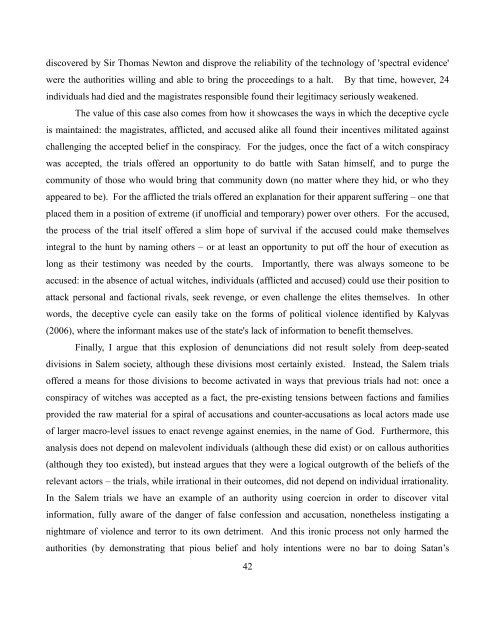The Torturer's Dilemma: Analyzing the Logic of Torture for Information
The Torturer's Dilemma: Analyzing the Logic of Torture for Information
The Torturer's Dilemma: Analyzing the Logic of Torture for Information
Create successful ePaper yourself
Turn your PDF publications into a flip-book with our unique Google optimized e-Paper software.
discovered by Sir Thomas Newton and disprove <strong>the</strong> reliability <strong>of</strong> <strong>the</strong> technology <strong>of</strong> 'spectral evidence'<br />
were <strong>the</strong> authorities willing and able to bring <strong>the</strong> proceedings to a halt. By that time, however, 24<br />
individuals had died and <strong>the</strong> magistrates responsible found <strong>the</strong>ir legitimacy seriously weakened.<br />
<strong>The</strong> value <strong>of</strong> this case also comes from how it showcases <strong>the</strong> ways in which <strong>the</strong> deceptive cycle<br />
is maintained: <strong>the</strong> magistrates, afflicted, and accused alike all found <strong>the</strong>ir incentives militated against<br />
challenging <strong>the</strong> accepted belief in <strong>the</strong> conspiracy. For <strong>the</strong> judges, once <strong>the</strong> fact <strong>of</strong> a witch conspiracy<br />
was accepted, <strong>the</strong> trials <strong>of</strong>fered an opportunity to do battle with Satan himself, and to purge <strong>the</strong><br />
community <strong>of</strong> those who would bring that community down (no matter where <strong>the</strong>y hid, or who <strong>the</strong>y<br />
appeared to be). For <strong>the</strong> afflicted <strong>the</strong> trials <strong>of</strong>fered an explanation <strong>for</strong> <strong>the</strong>ir apparent suffering – one that<br />
placed <strong>the</strong>m in a position <strong>of</strong> extreme (if un<strong>of</strong>ficial and temporary) power over o<strong>the</strong>rs. For <strong>the</strong> accused,<br />
<strong>the</strong> process <strong>of</strong> <strong>the</strong> trial itself <strong>of</strong>fered a slim hope <strong>of</strong> survival if <strong>the</strong> accused could make <strong>the</strong>mselves<br />
integral to <strong>the</strong> hunt by naming o<strong>the</strong>rs – or at least an opportunity to put <strong>of</strong>f <strong>the</strong> hour <strong>of</strong> execution as<br />
long as <strong>the</strong>ir testimony was needed by <strong>the</strong> courts. Importantly, <strong>the</strong>re was always someone to be<br />
accused: in <strong>the</strong> absence <strong>of</strong> actual witches, individuals (afflicted and accused) could use <strong>the</strong>ir position to<br />
attack personal and factional rivals, seek revenge, or even challenge <strong>the</strong> elites <strong>the</strong>mselves. In o<strong>the</strong>r<br />
words, <strong>the</strong> deceptive cycle can easily take on <strong>the</strong> <strong>for</strong>ms <strong>of</strong> political violence identified by Kalyvas<br />
(2006), where <strong>the</strong> in<strong>for</strong>mant makes use <strong>of</strong> <strong>the</strong> state's lack <strong>of</strong> in<strong>for</strong>mation to benefit <strong>the</strong>mselves.<br />
Finally, I argue that this explosion <strong>of</strong> denunciations did not result solely from deep-seated<br />
divisions in Salem society, although <strong>the</strong>se divisions most certainly existed. Instead, <strong>the</strong> Salem trials<br />
<strong>of</strong>fered a means <strong>for</strong> those divisions to become activated in ways that previous trials had not: once a<br />
conspiracy <strong>of</strong> witches was accepted as a fact, <strong>the</strong> pre-existing tensions between factions and families<br />
provided <strong>the</strong> raw material <strong>for</strong> a spiral <strong>of</strong> accusations and counter-accusations as local actors made use<br />
<strong>of</strong> larger macro-level issues to enact revenge against enemies, in <strong>the</strong> name <strong>of</strong> God. Fur<strong>the</strong>rmore, this<br />
analysis does not depend on malevolent individuals (although <strong>the</strong>se did exist) or on callous authorities<br />
(although <strong>the</strong>y too existed), but instead argues that <strong>the</strong>y were a logical outgrowth <strong>of</strong> <strong>the</strong> beliefs <strong>of</strong> <strong>the</strong><br />
relevant actors – <strong>the</strong> trials, while irrational in <strong>the</strong>ir outcomes, did not depend on individual irrationality.<br />
In <strong>the</strong> Salem trials we have an example <strong>of</strong> an authority using coercion in order to discover vital<br />
in<strong>for</strong>mation, fully aware <strong>of</strong> <strong>the</strong> danger <strong>of</strong> false confession and accusation, none<strong>the</strong>less instigating a<br />
nightmare <strong>of</strong> violence and terror to its own detriment. And this ironic process not only harmed <strong>the</strong><br />
authorities (by demonstrating that pious belief and holy intentions were no bar to doing Satan’s<br />
42
















